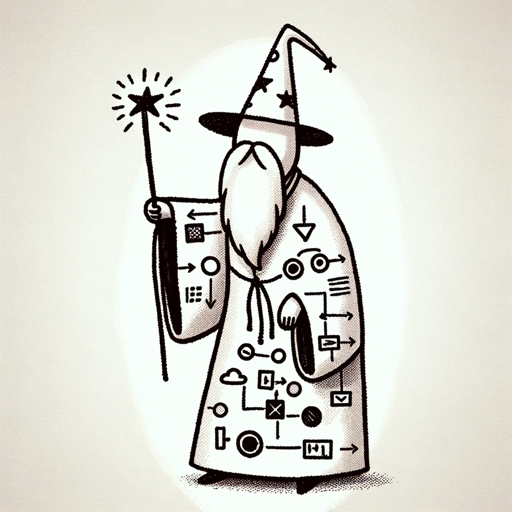LangGraph Wizard-AI-Powered LangGraph Solutions
AI-Powered Graph-Based Language Agents
Can you suggest a fun feature for my LangGraph agent?
Help me troubleshoot this error in my agent.
How can I make my agent more user-friendly?
What's a creative way to enhance my LangGraph agent?
Related Tools
Load More
Graph Maker
This GPT can provide guidance on the most appropriate type of graph for different data sets, such as bar charts, line graphs, pie charts, scatter plots, and more.

Dr. Graph
Expert at creating accurate graphs with researched data

Graph Theory
Friendly and patient guide in Graph Theory.

Whimsical Diagram Wizard
A creative guide for whimsical.com AI diagrams

PlantUML Diagram Wizard
A diagram wizard to the rescue

Conlang Creator
A guide for simplified conlang creation.
20.0 / 5 (200 votes)
Introduction to LangGraph Wizard
LangGraph Wizard is designed to facilitate the creation and optimization of LangGraph agents, specifically targeting simplicity and efficiency. It builds on the LangChain framework to enable the development of stateful multi-actor applications using language models. Unlike DAG frameworks, LangGraph allows for cyclic workflows essential for agent-like behaviors where actions are decided iteratively. For example, in a customer service chatbot, LangGraph can continuously loop through user queries and responses, dynamically deciding the next action based on the context of the conversation.

Main Functions of LangGraph Wizard
Stateful Multi-Actor Applications
Example
A virtual assistant that manages tasks such as scheduling meetings, setting reminders, and providing weather updates.
Scenario
The assistant can continuously interact with the user, update its state with each new piece of information, and decide on the next action based on the updated state.
Tool Integration and Execution
Example
An e-commerce chatbot that can search for products, provide recommendations, and assist with checkout processes.
Scenario
The chatbot can call different tools to perform searches, handle transactions, and update the conversation flow based on user inputs and tool outputs.
Conditional and Cyclic Workflows
Example
A troubleshooting bot for tech support that guides users through diagnostic steps and solutions.
Scenario
The bot can loop through diagnostic questions and actions, conditionally branching based on user responses and success of previous steps, until the issue is resolved or escalated.
Ideal Users of LangGraph Wizard Services
Developers and AI Engineers
Professionals looking to build complex, stateful applications with language models. They benefit from LangGraph's ability to handle cyclic workflows and integrate multiple tools seamlessly.
Businesses Implementing AI Solutions
Companies aiming to deploy AI-driven customer service, virtual assistants, or interactive agents. LangGraph Wizard simplifies the setup and management of these agents, allowing businesses to enhance user interactions and automate processes efficiently.

How to Use LangGraph Wizard
Visit aichatonline.org for a free trial without login, also no need for ChatGPT Plus.
Access the LangGraph Wizard without any sign-up or payment requirements.
Install necessary packages
Ensure you have the required Python packages: langchain, langgraph, tavily-python, and set up necessary environment variables like OPENAI_API_KEY.
Set up your tools
Define and configure the tools you want to use within your LangGraph application. For instance, you can use the Tavily search tool.
Define your model
Load and configure your chat model, ensuring it can handle messages and function calling. Bind the model to the tools you set up.
Create and compile your graph
Define the nodes, edges, and state for your graph. Use the StateGraph class to compile the graph and set entry and exit points. Then you can invoke it with your input data.
Try other advanced and practical GPTs
友邦吊顶智能客服
AI-driven solutions for perfect ceilings

Strategic & Marketing Plan Maker
AI-Driven Strategic & Marketing Solutions

Watercolor Clipart Creator
AI-powered watercolor clipart generator.

Technical Interview Judge
AI-powered technical interview evaluator

Create high converting Cover Letter
AI-powered high converting proposals
Inmerso Arquitectura
AI-powered design for modern architecture.

GOATgenius
Unleash absurd creativity with AI-powered GOATgenius!

Programinator
AI-powered software design assistance

以图攻图
AI-powered image analysis and regeneration

Book Cover Design Image Generator
Create stunning book covers with AI

PDF Summary
AI-Powered PDF Summarization Made Easy

ScriptReview
AI-powered script analysis for TikTok.

- Content Creation
- Data Analysis
- Customer Support
- Process Automation
- Workflow Management
Detailed Q&A about LangGraph Wizard
What is LangGraph Wizard used for?
LangGraph Wizard is a tool for building stateful multi-actor applications with LLMs, designed to facilitate complex workflows involving cycles and decision-making processes.
How do I install LangGraph Wizard?
You can install LangGraph Wizard and its dependencies using pip: `pip install langgraph langchain langchain_openai tavily-python`. Ensure you set up the necessary environment variables for your API keys.
What are the main components of a LangGraph application?
A LangGraph application consists of tools, a model, nodes, edges, and a stateful graph. Tools perform actions, the model processes messages, nodes represent actions, edges define the flow, and the graph manages the state.
Can LangGraph handle asynchronous workflows?
Yes, LangGraph supports asynchronous workflows. You can create async nodes to handle tasks concurrently, improving efficiency in handling multiple actions.
What are some use cases for LangGraph Wizard?
LangGraph Wizard is useful for applications requiring complex decision-making, such as chatbots with dynamic responses, multi-agent collaborations, and automated workflows that need to loop and adjust based on intermediate results.